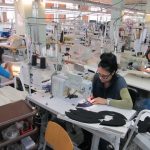
Thanks to the EU’s tough policies with regard to the use of hazardous chemical substances in textiles, consumers of textiles and clothing in advanced countries have a pretty good idea about the complex chemistry embedded in their clothes involving chemicals detrimental to the health and the environment. The EU’s REACH regulations have successfully created global awareness about the need of using safer chemicals in the industry. These laws enacted by the EU have now become almost mandatory for textile and apparel manufacturers the world over who wish to export their products to these countries and those who aim at achieving high reputation.
The strict monitoring of the use of banned chemicals has created immense challenges and opportunities for the manufacturers of textile specialty chemicals to focus on the development of innovative products and technologies based on safer chemistry that reduce or eliminate the use of hazardous chemicals. The good news for such enlightened manufacturers who sincerely want to explore safer chemistry for their product development is that brands are increasingly realizing that in the eyes of consumers they have a responsibility for both the chemicals on their garments and the process chemicals that are used in their manufacturing. Additionally, these consumers are empowered by the stricter rules being implemented by the various government agencies and a number of NGOs working in the field of consumer rights and protection. The stakeholders involved in the task of eliminating hazardous chemicals from the textile and apparel industry are: chemical suppliers, mills, brands, retailers, governments and the civil society. A serious debate and co-operation among all the stakeholders can help in highlighting the urgency of the need to explore the safer chemistry innovations. This can help manufacturers of specialty chemicals to demonstrate the key role they could play in the entire value chain and gain the support from other stakeholders in their efforts to avail the opportunities offered by the industry’s need for the safer chemistry innovation. This would ultimately benefit sincere innovators in attracting valuable support in terms of investment capital. This would also help actors outside the industry, such as investors, governments and the advocacy community, understand the opportunities available for their possible involvement in the initiatives planned by the innovators.
The T&C industry is facing increased pressure and scrutiny from consumers, advocacy groups and regulatory agencies to address the use of hazardous chemicals. To address this issue, textile manufacturers are now collaborating with the leading specialty chemical manufacturers and seeking a sort of package deal to provide most of the chemicals being used by them. Of course, the chemical manufacturers/suppliers have to give a sort of an undertaking that the products being supplied by them comply with all the relevant legislations with regard to their safety. Leading global brands, on the other hand, are addressing their supply chain liabilities with regards to the use of potentially hazardous chemicals by resorting to increasing transparency by gathering and providing all the required information about chemicals and materials used in their products during the various manufacturing processes. They are also actively promoting consumer awareness about the adverse effects of the banned chemicals by highlighting them in their company/brand profiles.
Let’s hope that in the coming years more and more textile manufacturers resort to insisting on using innovative products based on safer chemistry and totally discard chemicals of concern in their production processes. This will greatly accelerate the adoption of new technologies that reduce or eliminate the use of hazardous chemicals.
G.D. JASUJA
Managing Editor





